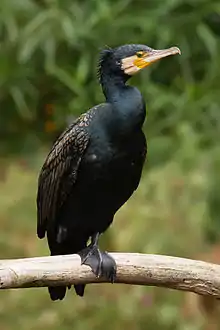Phalacrocorax
Phalacrocorax is a genus of fish-eating birds in the cormorant family Phalacrocoracidae. Members of this genus are also known as the Old World cormorants.
| Phalacrocorax | |
|---|---|
 | |
| Great cormorant (Phalacrocorax carbo) | |
| Scientific classification | |
| Kingdom: | Animalia |
| Phylum: | Chordata |
| Class: | Aves |
| Order: | Suliformes |
| Family: | Phalacrocoracidae |
| Genus: | Phalacrocorax Brisson, 1760 |
| Type species | |
| Pelecanus carbo | |
| Species | |
|
12, see text | |
| Synonyms | |
| |
Taxonomy
The genus Phalacrocorax was introduced by the French zoologist Mathurin Jacques Brisson in 1760 with the great cormorant (Phalacrocorax carbo) as the type species.[1][2] Phalacrocorax is the Latin word for a "cormorant".[3]
Formerly, many other species of cormorant were classified in Phalacrocorax, but most of these have been split out into different genera. A 2014 study found Phalacrocrax to be the sister genus to Urile, which are thought to have split from each other between 8.9 - 10.3 million years ago.[4]
Current taxonomy
A molecular phylogenetic study published in 2014 found that the genus Phalacrocorax contains 12 species.[4] This taxonomy was adopted by the IUCN Red List and BirdLife International, and later by the IOC.[5]
- Bank cormorant or Wahlberg's cormorant, Phalacrocorax neglectus
- Socotra cormorant, Phalacrocorax nigrogularis
- Pitt shag or Featherstone's shag, Phalacrocorax featherstoni
- Spotted shag, Phalacrocorax punctatus
- Black-faced cormorant, Phalacrocorax fuscescens
- Australian pied cormorant or yellow-faced cormorant, Phalacrocorax varius
- Little black cormorant, Phalacrocorax sulcirostris
- Indian cormorant, Phalacrocorax fuscicollis
- Cape cormorant, Phalacrocorax capensis
- Japanese cormorant or Temminck's cormorant, Phalacrocorax capillatus
- White-breasted cormorant, Phalacrocorax lucidus
- Great cormorant or black shag, Phalacrocorax carbo
Alternative taxonomies
Formerly, the genus Phalacrocorax included all members of the genera Poikilocarbo, Urile, Gulosus, Nannopterum, and the rock shag of Leucocarbo, all of which are now understood to belong to different genera.[6]
The taxonomy adopted by the Clements Checklist classifies all cormorants aside from those already in Microcarbo into Phalacrocorax, leaving just two cormorant genera: Phalacrocorax and Microcarbo.
References
- Brisson, Mathurin Jacques (1760). Ornithologie, ou, Méthode Contenant la Division des Oiseaux en Ordres, Sections, Genres, Especes & leurs Variétés (in French and Latin). Paris: Jean-Baptiste Bauche. Vol. 1, p. 60, Vol. 6, p. 511.
- Mayr, Ernst; Cottrell, G. William, eds. (1979). Check-list of Birds of the World. Vol. 1 (2nd ed.). Cambridge, Massachusetts: Museum of Comparative Zoology. p. 163.
- Jobling, J.A. (2019). del Hoyo, J.; Elliott, A.; Sargatal, J.; Christie, D.A.; de Juana, E. (eds.). "Key to Scientific Names in Ornithology". Handbook of the Birds of the World Alive. Lynx Edicions. Retrieved 9 April 2019.
- "Classification of the cormorants of the world". Molecular Phylogenetics and Evolution. 79: 249–257. 2014-10-01. doi:10.1016/j.ympev.2014.06.020. ISSN 1055-7903.
- "Taxonomic Updates – IOC World Bird List". Retrieved 2021-07-28.
- Kennedy, M.; Spencer, H.G. (2014). "Classification of the cormorants of the world". Molecular Phylogenetics and Evolution. 79: 249–257. doi:10.1016/j.ympev.2014.06.020. PMID 24994028.